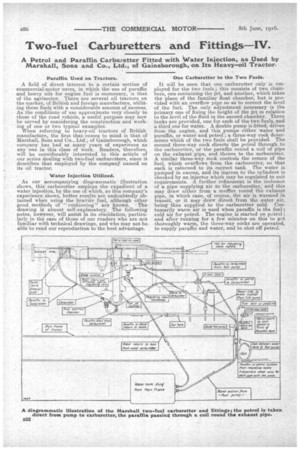Two.fuel Carburetters and Fittings—IV.
Page 4

If you've noticed an error in this article please click here to report it so we can fix it.
A Petrol and Paraffin Carburetter Fitted with Water Injection, as Used by Marshall, Sons and Co., Ltd., of Gainsborough, on Its Heavy-oil Tractor.
Paraffin Used on Tractors.
A field of direct interest to a certain section of commercial-motor users, in which the use of paraffin and heavy oils for engine fuel is customary, 18 that of the agrimotor. There are several oil tractors on the market, of British and foreign manufacture, utilizing these fuels with a considerable amount of success. As the conditions of use approximate very closely to those of the road vehicle, a useful purpose may now be served by considering the construction and workMg of one or two typical example.
When referring to heavy-oil tractors of British manufacture, the first that comes to mind is that of Marshall, Sons and Co., Ltd., of Gainsborough, which company has had as .many years of experience as any one in this class of work. Readers, therefore, will be considerably interested in this article of our series dealing with two-fuel carburetters, since it describes that employed by the companS' named on its oil tractor.
Water Injection Utilized.
As our accompanying diagrammatic illustration shows, this carburetter employs the expedient of a water injection, by the use of which, as this company's experience shows, better results are undoubtedly ohtamed when using the heaiier fuel, although other good methods of "cushioning" are known. The drawing is almost self-explanatory. The following notes, however, will assist in its elucidation, particularly in the case of those of our readers who are not familiar with te-chnical drawings, and who may not be able to read our reproduction to the best advantage.
One Carburetter to the Two Fuels.
It will be seen that one carburetter only is employed for the two fuels ; this consists of two chambers, one containing the jet, and another, which takes the place of the familiar float chamber; but is provided with an overflow pipe so as to correct the level of the fuel. The only adjustment necessary is the primary one of fixing the height of the jet in relation to the level of the fluid in the second chamber. Three tanks are provided, one for each of the two fuels, and a third one for water. A double pump is fitted, driven from the engine, and this pumps either water and paraffin, or water and petrol; a three-way cock determines which of the two fuels shall be provided. The second three-way cock directs the petrol through to the carburetter, or the paraffin round a coil of pipe on the exhaust pipe, and thence to the carburetter. A similar three-way cock controls the return of the fuel, which overflows from the carburetter, so that each is returned to its correct tank. The water is pumped in excess, and its ingress to the cylinders is checked by an injector which may be regulated to snit requirements. A further refinementis the inclusion of a pipe supplying Air to the carburetter, and this may draw either from a muffler round the exhaust pipe, in which case, of course,, the air is warmed in transit, or it may draw direct from the •outer air, being' thus supplied to the carburetter cold. Customarily warm air is used when paraffin is the fuel-; cold air for petrol. The engine is started on petrol ; and after running for a few minutes on this to get thoroughly warm, the three-way cocks' are operated, to supply paraffin and water, and to shut off petrol,






















